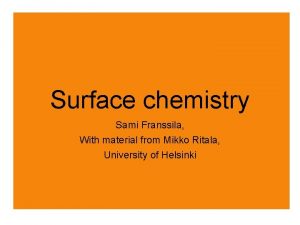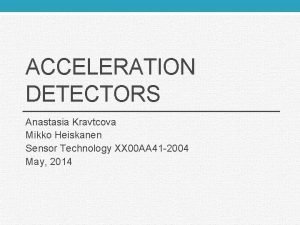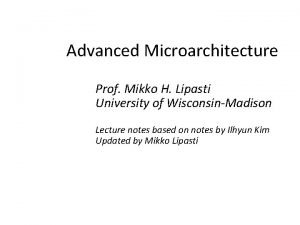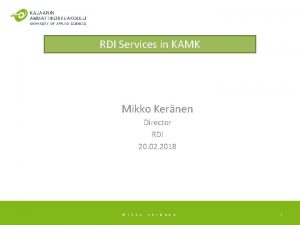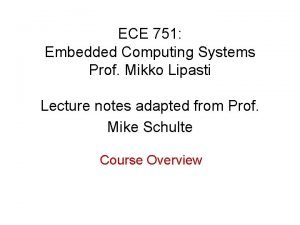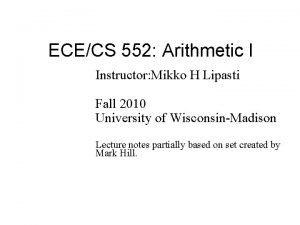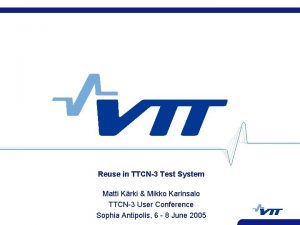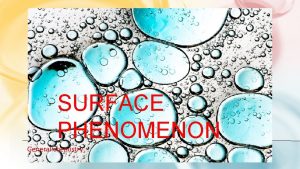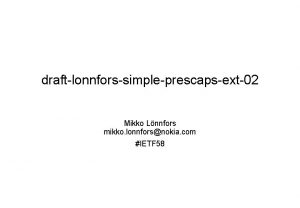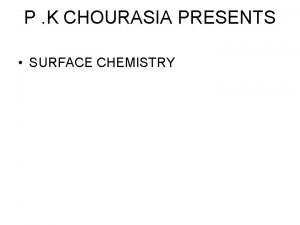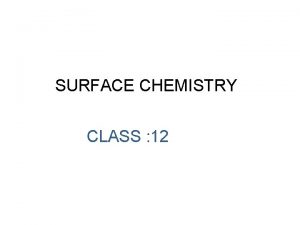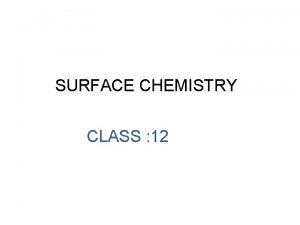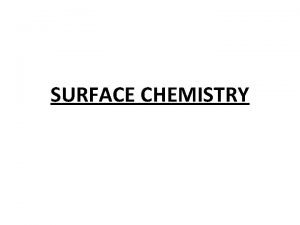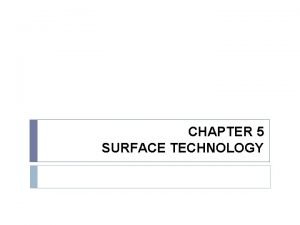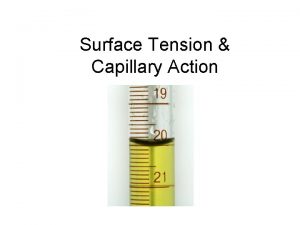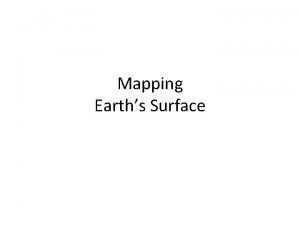Surface chemistry Sami Franssila With material from Mikko













































- Slides: 45

Surface chemistry Sami Franssila, With material from Mikko Ritala, University of Helsinki

Surface energy Seong et al: Dominant mechanisms of the sintering of copper nano-powders, 2016

Surface tension


Surface energy of solids

Estimating surface energy

Silicon surface energy Silicon atom surface density, ca. 1015 cm-2, and hydrogen bond energies, 25 -40 k. J/mol, which translate to ca. 200 -350 m. J/m 2. Tong, Q. -Y. & U. Gösele: Semiconductor Wafer Bonding, John Wiley & Sons, 1999 Surface energies calculated from Si – O bond energies (4. 5 e. V/bond or 430 k. J/mol) translate to ca. 3000 m. J/m 2.

Surface energy of metals

Surface energy of metals (2) Rule of thumb: -stabilty comes from high surface atom density and high coordination number.

Surface energy vs. melting point Bond strength determines both.

Silicon surface termination a) Negatively charged oxygen attracts positively charged H+ b) Negatively charge H+ repels negatively charged oxygen Hattori, T. (ed. ): Ultraclean surface processing of silicon wafers,

Modifying surface chemistry Methyl-terminated, -CH 3 Hydrophobic Oxygen plasma treatment turns some methyl groups to hydroxyl OH-, groups hydrophilic

SAMs (Self-assembled monolayers) time Either in liquid phase or gas phase deposition.

Silane-SAM

Self-cleaning mirrors/windows

Adsorption

Atoms hitting the surface may: 1. Bounce back -elastic scattering without energy loss -inelastic scattering with energy loss 2. Stay on surface -by weak interaction: physisorption -by strong interaction: chemisorption 3. Act on surface: -surface diffusion -surface reactions -desorption

Adsorption concepts

Coverage Θ

Adsorbate fate on surface -move around by surface diffusion -fragment -react with substrate -react with co-adsorbed specie -react with gas phase specie -desorb Products may be volatile and desorb; or form film on surface http: //staff. ustc. edu. cn/~bjiangch/research. html

Reactive adsorption

Physisorption

Xenon atoms physisorbed Each xenon atom appears as a 1. 6 -A-high bump on the surface, The xenon atoms are spaced on a rectangular grid which is four nickel unit cells long horizontally and five unit cells long vertically, corresponding to 14 x 12. 5 A. “…use of the STM at low temperatures (4 K) to position individual xenon atoms on a single-crystal nickel surface with atomic precision. The tip of an STM always exerts a finite force on an adsorbate atom. This force contains both Van der Waals and electrostatic contributions. By adjusting the position and the voltage of the tip we may tune both the magnitude and direction of this force. This, taken together with the fact that it generally requires less force to move an atom along a surface than to pull it away from the surface, makes it possible to set these parameters such that the STM tip can pull an atom across a surface while the atom remains bound to the surface. ” Eigler & Schweitzer, Nature 1990

Chemisorption

Chemisorption vs. physisorption

Important surface reactions

Catalysis

Heterogenous catalysis

Reaction co-ordinates It might be that homogeneous uncatalyzed reaction is replaced by heterogeneous catalyzed reaction. https: //cnx. org/contents/RTmu. Ixz. M@3. 4: b. Zvv 2 PMU@4/Catalysis

Nobel prize 2007: Gerhard Ertl

Devil is in the details Different catalysts

Pt/C nanoparticle catalyst For instance, holes in carbon coating may expose a single Pt -atom; or several orientation of entering molecule different end result Jiang et al: Adv. Funct. Mater. 2020, 30, 2003321

ALD-coated Pt-catalyst ALD films <1 nm are discontinuous gas molecules have access to noble metal catalyst. But reaction product molecules are too big to enter. Cao et al. : Catalysts design and synthesis via selective ALD, JVST A 2018

Stabilization by coating b and c – samples both 600 o. C anneal Nanoporous gold wants to minimize area, but ALD films prevent this. In b) nanoscale structures protected by ALD film remain; In c) unprotected nanoscale structures have coalesced into larger microstructures Biener et al: ALD Functionalized Nanoporous Gold: Thermal Stability, Mechanical Properties, and Catalytic Activity, Nanoletters 2011

Facet selective deposition The facet selectivity was realized through the intrinsic differences in binding energies of Ce precursor fragments chemisorbed on Pt surfaces. Fe 3 O 4 on Pt, and Ti. O 2 on Au, there is a strong tendency to first nucleate on the egde/low coordinated sites. Cao et al. : Catalysts design and synthesis via selective ALD, JVST A 2018

Crystal plane dependent etching Some crystal planes etch much faster than others. In silicon, (100) planes etch 100 X faster than (111) planes. (111) 54. 7 o (100)

Bond density at surface

One layer at a time 4 bonds in bulk 2 bonds at surface https: //pmc. polytechnique. fr/spip. php? article 580&lang=fr

Patterning of catalyst Cao et al. : Catalysts design and synthesis via selective ALD, JVST A 2018

Graphene oxide catalyst “Co–N 4 moieties are surrounded by the desired configuration of electron-rich oxygen atoms from graphene oxide substrates. ” Jiang et al: Adv. Funct. Mater. 2020, 30, 2003321

Industrial catalytic processes

Size scales of catalysis Chemistry & physics & computational science Materials science Chemical engineering

Real surfaces…

More real surfaces Belkind & Gershman; Vacuum Technology and Coatng 2008

Surface functionalization Chatterjee et al: Core/shell nanoparticles in biomedical applications, 2014
 Sami franssila
Sami franssila Mikko ranta-huitti
Mikko ranta-huitti Mikko kesonen
Mikko kesonen Mikko posti
Mikko posti Mikko häikiö
Mikko häikiö Tea heininen
Tea heininen Mikko juusela
Mikko juusela Mikko manka tampereen yliopisto
Mikko manka tampereen yliopisto Mikko heiskanen
Mikko heiskanen Mikko vienonen
Mikko vienonen Mikko sola
Mikko sola Mikko karppinen
Mikko karppinen Mikko lipasti
Mikko lipasti Mikko lappalainen
Mikko lappalainen Mikko keränen kamk
Mikko keränen kamk Mikko mäkelä metropolia
Mikko mäkelä metropolia Mikko ranta njs
Mikko ranta njs Mikko ulander
Mikko ulander Mikko h. lipasti
Mikko h. lipasti Mikko lindeman
Mikko lindeman Mikko h. lipasti
Mikko h. lipasti Mikko prii
Mikko prii Mikko tiira
Mikko tiira Mikko nieminen
Mikko nieminen Mikko h. lipasti
Mikko h. lipasti Mikko lipasti
Mikko lipasti Mikko bentlin
Mikko bentlin Mikko huovila
Mikko huovila Mikko routala
Mikko routala Mikko h. lipasti
Mikko h. lipasti Mikko lipasti
Mikko lipasti Mikko h. lipasti
Mikko h. lipasti Mikko lipasti
Mikko lipasti System by mikko
System by mikko Mikko lipasti
Mikko lipasti Mikko saastamoinen
Mikko saastamoinen Ecc syndrome
Ecc syndrome Ericsson psirt
Ericsson psirt Geometrical symbol
Geometrical symbol Material yield variance arises due to change in the
Material yield variance arises due to change in the What is cultural divergence
What is cultural divergence Refers to the knowledge language values customs
Refers to the knowledge language values customs Examples of non material culture
Examples of non material culture 10 household materials useful and harmful
10 household materials useful and harmful Ib chemistry organic chemistry
Ib chemistry organic chemistry Organic vs inorganic chemistry
Organic vs inorganic chemistry
